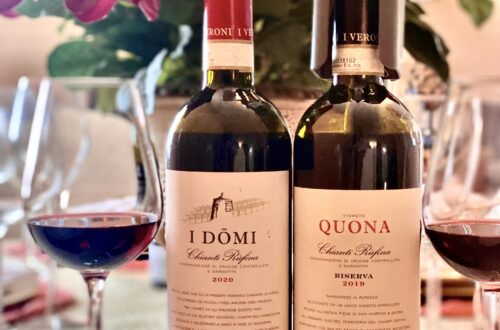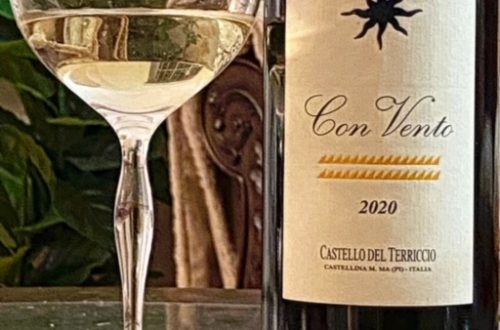Rosé from the Rolling Hills of Tuscany
 With so much to eat, drink, see and do and such rich history, where does one begin when writing about Tuscany?! Tuscany a marvelous region in central Italy that borders Liguria to the northwest, Emilia-Romagna to the north and east, Umbria to the east and Lazio to the southeast. It stretches from the Apennines to the Tyrrhenian Sea and consists of the provinces of Arezzo, Florence (the capital), Grosseto, Livorno, Lucca, Massa-Carrara, Pisa, Pistoia, Prato and Siena. Tuscany, specifically Florence, is known as the birthplace of
With so much to eat, drink, see and do and such rich history, where does one begin when writing about Tuscany?! Tuscany a marvelous region in central Italy that borders Liguria to the northwest, Emilia-Romagna to the north and east, Umbria to the east and Lazio to the southeast. It stretches from the Apennines to the Tyrrhenian Sea and consists of the provinces of Arezzo, Florence (the capital), Grosseto, Livorno, Lucca, Massa-Carrara, Pisa, Pistoia, Prato and Siena. Tuscany, specifically Florence, is known as the birthplace of

the Italian Renaissance and the home of many influential figures in terms of banking and finance (think The Medici Family), art and architecture (think Leonardo Da Vinci and Michelangelo), science (think Galileo) and much more. Several things make the Tuscan region a prime tourist destination. Tuscany has the beautiful Duomo, Santa Maria Novella, numerous monuments, many well-known museums (Uffizi, Pitti Palace, Galeria Dell’Accademia) and houses UNESCO World Heritage sites such as the Orcia Valley, Pienza, Pisa (Leaning Tower), Siena (Palio), San Gimignano. The list goes on. Moreover, Tuscany is a major wine producer of some of the worlds top wines including Chianti, Brunello di Montalcino, Morellino di Scansano, Vernaccia, Vino Nobile di Montepulciano and Vin Santo. From amazing art and architecture and an unparalleled landscape full of rolling hills, beautiful beaches and the Cinque Terre, to wine, olive oils and truffles–Tuscany has it all. Tuscany also produces Rosé.
Tuscan rosés, better known as
vino rosato, are usually made from the native Sangiovese grapes. Therefore, the characteristics are very similar to Chiantis and exude huge red fruit flavors. Typical flavors include cherry, wild strawberry, raspberry and clove. Tuscan rosato will pair with typical Tuscan fare, of course. It would also pair with melon, proscuitto, salads and paninis. There are three methods used to make rosé wine: direct pressing of red wine grapes for a short period of time, bleeding of the must (also known as the saignée method), and blending white and red wines. The amount of time the grapes are in contact with the skins dictates the color or the shade of the wine. As the shade differ, the sweetness level and type of rosé wine differs; some may be still, others may be sparkling.
The Wining Hour’s Tuscany Rosé Selections:
We selected 3 rosés from different parts of the Tuscan region: Greve in Chianti, Siena and Bolgheri.
 Cinciano Gotifredo Rosato (Siena)
Cinciano Gotifredo Rosato (Siena)
I have enjoyed Cinciano wines many times. Gotifredo Rosato is produced from 100% Sangiovese grapes, which make it a pink Chianti. The grapes are harvested manually. According to Cinciano, this rosato is “produced from the younger vines and the aromas are preserved by means of cold. Thus it expresses very high finesse and intensity.” Gotifredo Rosato is light pink in appearance and had notes of strawberry, peach and clay pot minerals. This minerality is likely due to the fact that the vineyards are at 200 meters of altitude with southwest exposure and chalky soil, providing rich structure and a little clay. This minerality is also on the palate, along with honeydew melon, and strawberry. Cinciano’s Gotifredo Rosato is a light to medium bodied wine with 13.5% ABV, that would accompany fish, chicken, salads or alone as an aperitivo. Fresh, with a long finish.
Villa Canaiolo Rosato (Greve in Chianti)

This rosé is from Conte Capponi in the Chianti Classico area. It is made from 100% *Canaiolo grapes all harvested by hand. The grapes were fermented in stainless steel tanks after 6 hours of skin contact. Fermentation lasts about eight days at a maximum temperature of 20°C. Villa Canaiolo Rosato a is light and refreshing wine that has a light salmon appearance and a nose of grapefruit and citrus blossom. On the palate were notes of tangy red fruits like bitter cherries and cranberry. Villa Canaiolo Rosato would pair well with most things. Fish, chicken and vegetarian dishes are good choices. Medium bodied, moderate acidity and balanced with 12% ABV.
*Canaiolo is a red grape grown throughout Central Italy but is most noted in Tuscany. It is used along with with Sangiovese and Colorino to create Chianti wine and is also used for Vino Nobile di Montepulciano.
Scalabrone Rosato DOC (Bolgheri):
This rosé is from Tenuta Guado al Tasso in Bolgheri, which is on the south west coast of the Tuscan region. The Guado al Tasso estate extends from the Tyrrhenian sea to the inland hills. This rosé gets its name from a Robin Hood-esq bandit who lived in the area in the 19th century and attacked ships in the port and canal of Bolgheri. This rosate is made from 40% Cabernet Sauvignon, 30% Merlot, 30% Syrah. Each grape variety was harvested and cultivated to produce Scalabrone was fermented separately. The harvested grapes are then de-stemmed and soft-pressed. Next, maceration with the skins occurs at low temperatures for a period of three to five hours on the basis of the characteristics of the individual variety in order to obtain a must without astringent notes. Finally, the must is fermentated and aged in temperature-controlled stainless steel tanks.
Scalabrone Rosato is yet another delicious wine from the Antinori family. This Bolgheri rosé has a bright pink color and aromas of cherries, raspberries and flowers. The palate has a lingering finish of rose petals and raspberries. Due to the grape varietals used, this 12.5% rosé could handle beef, spicy food, mature and hard cheese and chicken.
When pondering how Italian Tuscan rosé compares to its worldly counterparts, we would say that it all boils down to a matter of taste. Some enjoy the lighter, drier rosés, others enjoy more fruit forward rosés, while others prefer sweeter rosé wines. Tuscan rosato suits us just fine.
Have you tasted Tuscan rosato?
If you enjoy a good rosé and want to hear more about these pink wines in Italy, you’re in for a treat….
Want More on Italian Rosé?Join us this Saturday, August 6 at 11am EST on Twitter at #ItalianFWT to chat about Rosé wines from Italy. Check out what our Italian blogging group has lined up for you:
About The Wining Hour
The Wining Hour writes about wine, Italy and global travel. The Wining Hour boutique caters to wine-lovers across the globe by offering all wine-related items. The Wining Hour markets unique wine décor and furnishings, accessories, glassware, barware, wine racks, storage and cooling options, games, gifts and more. The Wining Hour also hosts #wininghourchat on Twitter (@wininghourchat) on Tuesday’s at 9 p.m. EST.(For more, see links at the top of this page)
Follow The Wining Hour:
 With so much to eat, drink, see and do and such rich history, where does one begin when writing about Tuscany?! Tuscany a marvelous region in central Italy that borders Liguria to the northwest, Emilia-Romagna to the north and east, Umbria to the east and Lazio to the southeast. It stretches from the Apennines to the Tyrrhenian Sea and consists of the provinces of Arezzo, Florence (the capital), Grosseto, Livorno, Lucca, Massa-Carrara, Pisa, Pistoia, Prato and Siena. Tuscany, specifically Florence, is known as the birthplace of
With so much to eat, drink, see and do and such rich history, where does one begin when writing about Tuscany?! Tuscany a marvelous region in central Italy that borders Liguria to the northwest, Emilia-Romagna to the north and east, Umbria to the east and Lazio to the southeast. It stretches from the Apennines to the Tyrrhenian Sea and consists of the provinces of Arezzo, Florence (the capital), Grosseto, Livorno, Lucca, Massa-Carrara, Pisa, Pistoia, Prato and Siena. Tuscany, specifically Florence, is known as the birthplace of the Italian Renaissance and the home of many influential figures in terms of banking and finance (think The Medici Family), art and architecture (think Leonardo Da Vinci and Michelangelo), science (think Galileo) and much more. Several things make the Tuscan region a prime tourist destination. Tuscany has the beautiful Duomo, Santa Maria Novella, numerous monuments, many well-known museums (Uffizi, Pitti Palace, Galeria Dell’Accademia) and houses UNESCO World Heritage sites such as the Orcia Valley, Pienza, Pisa (Leaning Tower), Siena (Palio), San Gimignano. The list goes on. Moreover, Tuscany is a major wine producer of some of the worlds top wines including Chianti, Brunello di Montalcino, Morellino di Scansano, Vernaccia, Vino Nobile di Montepulciano and Vin Santo. From amazing art and architecture and an unparalleled landscape full of rolling hills, beautiful beaches and the Cinque Terre, to wine, olive oils and truffles–Tuscany has it all. Tuscany also produces Rosé.
the Italian Renaissance and the home of many influential figures in terms of banking and finance (think The Medici Family), art and architecture (think Leonardo Da Vinci and Michelangelo), science (think Galileo) and much more. Several things make the Tuscan region a prime tourist destination. Tuscany has the beautiful Duomo, Santa Maria Novella, numerous monuments, many well-known museums (Uffizi, Pitti Palace, Galeria Dell’Accademia) and houses UNESCO World Heritage sites such as the Orcia Valley, Pienza, Pisa (Leaning Tower), Siena (Palio), San Gimignano. The list goes on. Moreover, Tuscany is a major wine producer of some of the worlds top wines including Chianti, Brunello di Montalcino, Morellino di Scansano, Vernaccia, Vino Nobile di Montepulciano and Vin Santo. From amazing art and architecture and an unparalleled landscape full of rolling hills, beautiful beaches and the Cinque Terre, to wine, olive oils and truffles–Tuscany has it all. Tuscany also produces Rosé. Cinciano Gotifredo Rosato (Siena)
Cinciano Gotifredo Rosato (Siena) 







